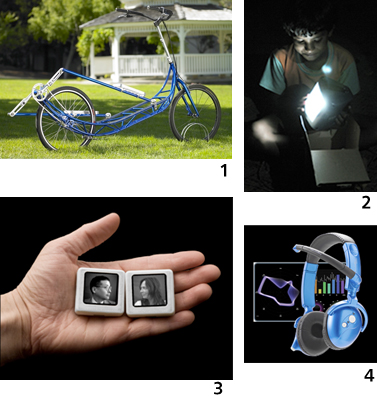Video games that read your mind. A bike that you run on instead of pedal. Really, what could be more California than Stanford’s annual Cool Product Expo? We spoke with Amanda Kaye Boaz, a second-year MBA student at Stanford GSB and co-organizer of this geek- and green-friendly celebration of innovative products.

Four products at this year's event: 1) Elliptigo Glide Bike; 2) D.Light Design's efficient LED lighting; 3) Siftables; and 4) NeuroSky's video game
First of all, what is the Cool Product Expo?
Last year we had about 800 attendees, including current students, alumni, local professionals, press, etc. It’s open to anybody. It is the largest student-run event on campus, and we are really fortunate because of our location in the Bay Area. There are a lot of start-ups that come out with really cool, innovative products.
We typically get about 50 exhibitors from around the area who are launching products that we think are really innovative and cutting-edge. For instance, this year we are having someone over who found a way to let you play video games with your mind. They have neurosensors that they attach to your head, and with these you can actually move the characters on the video game.
So, I assume most of the “cool” products are high-tech things.
By the nature of where we are located we have a little more technology, but it’s not just technology. We will have clean-tech cars, and Cal Cars that convert Priuses into plug-in electric vehicles. Last year, we had GM come with their electric vehicle. We are hoping to get them to come again this year.
It’s a lot of everything. We have a number of booths for current student projects. We’re having people in the engineering school who made irrigation systems for developing countries, and another student coming who is bringing an extension for people who don’t have use for their hands, so they can actually play golf.
This strikes me as kind of a typical California thing – a mix of entrepreneurship, design, technology, and innovation. Do a lot of Stanford MBA students end up doing this kind of thing?
Yes, definitely. I think a lot of students spread to other graduate schools at Stanford. Many actually don’t go through formal job recruiting, and are more interested to go to work for start-ups, which we are really fortunate to have in the area. It’s definitely a different feel. A lot of our classes are structured around that entrepreneurship angle, which is exciting.
What classes does one take at Stanford if you’re interested in entrepreneurship?
We have our typical foundation or core courses. But on the more entrepreneurial track, we have a class called “Formation of New Ventures” and a class where you spend the winter quarter developing a business plan of a company that you want to start, and in the spring quarter, you work on actually implementing that business plan. It’s a great way for students to use that class structure and faculty advisor to really help to get some of these ideas off the ground.
Are you interested in working with design in the future?
I’m definitely interested in doing that in the future. I was really interested in the d.school (Stanford Institute of Design), which partners with other graduate schools at Stanford. It’s a great environment where you learn the whole design thinking process. People from the engineering school with technical expertise that we don’t have.
One of the most popular classes at the d.school is called “Design for Extreme Affordability.” It’s a two-quarter class, and the class is geared toward designing for developing nations. The winter quarter you spend developing something, and during the spring quarter, you go to developing countries and test out whether it is something that can actually be used. It’s really about designing a product that can be sold to someone who earns less than a dollar a day.
I applied for one class this spring called “Designing for a Sustainable Abundance,” so it’s along the lines of how you can design with less waste; thinking about how to market products that are environmentally friendly to consumers who might not care about that.
Is this what you want to do when you finish the MBA?
I’ve decided to move back into consulting after school, and the company I’m going to work for is building up their sustainable, alternative energy practice. At this point I’m not really sure whether I want to go to work for a green tech company for business development, or a more sustainability route. I thought that consulting would be a good way to look at it from a holistic level.
Products shown in top photos: 1) Elliptigo Glide Bike; 2) D.Light Design’s efficient LED lighting; 3) Siftables; and 4) NeuroSky’s MindSet
Photos Courtesy: Amanda Kaye Boaz

Pingback: Doing More With Less, and Bigger than Ever « Stanford Cool Product Expo / 2009
Pingback: Find MBA Blog Critique | Graduate school blog reviews